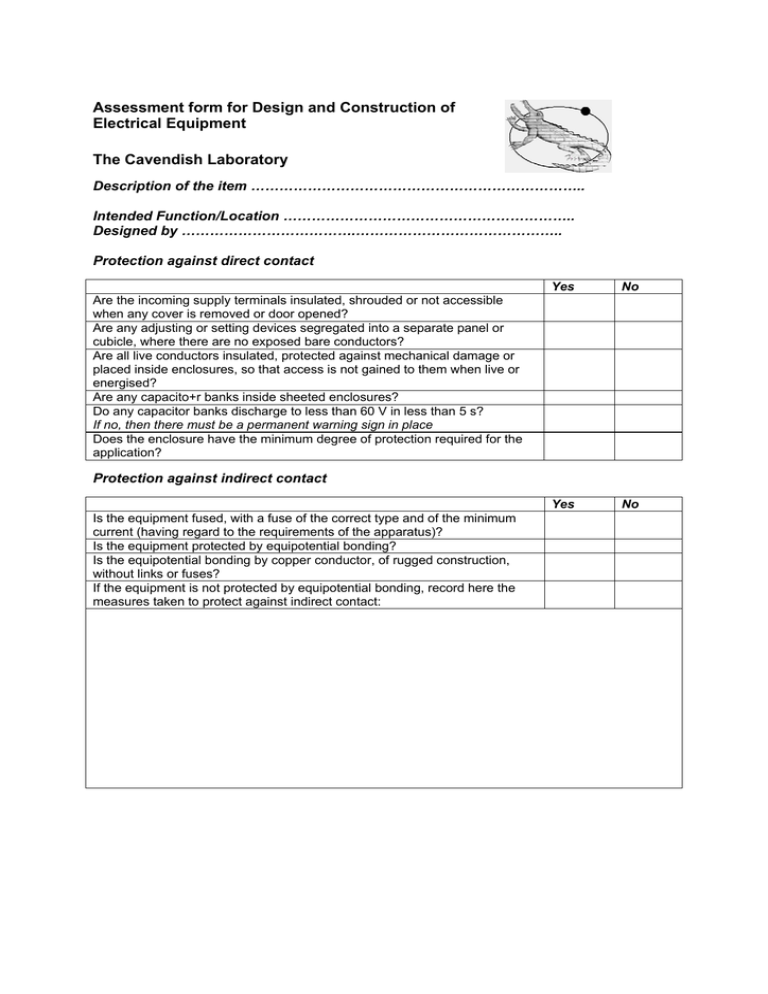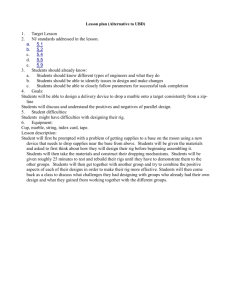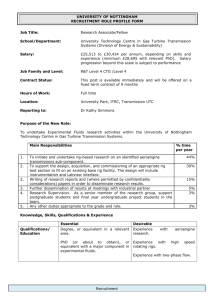Design checklist - Cavendish Laboratory
advertisement

Assessment form for Design and Construction of Electrical Equipment The Cavendish Laboratory Description of the item …………………………………………………………….. Intended Function/Location …………………………………………………….. Designed by ……………………………….…………………………………….. Protection against direct contact Yes No Yes No Are the incoming supply terminals insulated, shrouded or not accessible when any cover is removed or door opened? Are any adjusting or setting devices segregated into a separate panel or cubicle, where there are no exposed bare conductors? Are all live conductors insulated, protected against mechanical damage or placed inside enclosures, so that access is not gained to them when live or energised? Are any capacito+r banks inside sheeted enclosures? Do any capacitor banks discharge to less than 60 V in less than 5 s? If no, then there must be a permanent warning sign in place Does the enclosure have the minimum degree of protection required for the application? Protection against indirect contact Is the equipment fused, with a fuse of the correct type and of the minimum current (having regard to the requirements of the apparatus)? Is the equipment protected by equipotential bonding? Is the equipotential bonding by copper conductor, of rugged construction, without links or fuses? If the equipment is not protected by equipotential bonding, record here the measures taken to protect against indirect contact: General Measures Yes No Has the designer done a risk assessment to establish that the design does not pose danger under both the normal use, and the reasonably foreseeable misuse, or fault conditions? (attach design calculations where appropriate) Is there a circuit diagram? Is there a functional diagram? (Please store both with this document). Are plugs and sockets provided of such design as to ensure that the wrong connections are not made, if necessary to prevent danger? Are plugs and sockets suited to their purpose? Does the equipment have appropriate warning signs? Is the general construction mechanically sound? Testing Test Pass Continuity of protective bonding circuit (record p.d. measured) Insulation resistance Voltage test: At ……………V Items disconnected are recorded below Residual voltages Record discharging arrangements below Functional tests EMC compatibility tests (where appropriate) Space for Observations and Clarification: This equipment appears to be constructed to be fit for purpose. Assessment carried out by ……………………………… Date …………… Fail/ not appropriate (give reasons below) Assessment Form for Integration of Electrical Equipment into an Experimental Rig The Cavendish Laboratory Location of rig ……………………………………………………… Intended function …………………………………………………… Yes Add up the power (or current) requirements of the individual items in the rig Is the incoming supply cable of the correct rating and fused correctly? Note: recording currents to the nearest 0.5 A is sufficient, and 13 A at mains voltage is equivalent to approx 2.9 kW. Is the rig powered from a single source (preferred)? If not, is it clear which parts are powered from which source(s)? ………. Is the incoming line placed to avoid slips, trips, damage from abrasion, liquid nitrogen, immersion of live parts in water? Has the earth connection been checked to establish its integrity? If safety is to be achieved by some other means record this below. Is the equipment placed in the rig so as to avoid overheating? Have the items of equipment been connected to distribution boards so as to avoid daisy-chaining and the use of adaptor blocks? Is it obvious how to disconnect the apparatus in an emergency (to people other than the users)? If not obvious by position, is there adequate labelling? Is it obvious how to disconnect the apparatus from all other sources of energy or associated hazards (e.g. water, compressed air, cryogens) Is the means to turn off the electrical supply in an emergency readily accessible and free from obstacles? No Continued: Yes Is there a means to isolate the equipment so that it remains dead? (could be the same as the disconnection – if it is powered from a plug/socket arrangement the answer will be yes provided sufficient steps are taken to prevent inadvertent reconnection). Are all live conductors (that might constitute a danger) on any associated apparatus shrouded or insulated to prevent contact? Is any associated apparatus earthed where necessary to prevent danger? Are all high voltage connectors (if any) arranged so that contact cannot be made with them while live (e.g. if the connector is removed from the rig while the power supply is ‘on’.)? Have any radiation sources (e.g. RF) been assessed quantitatively, suitable shielding measures taken, and the shields tested? (enter details below) Is an RCD required? (in general for locations where water may increase the hazard, or where conductors are easily damaged, such as a workshop floor) Is an emergency red button needed? (e.g. where live electrical work is foreseeable) Have the users of the rig been shown this risk assessment, and the risk assessment(s) pertaining to the items that constitute the rig? Name the users: Have they been told of the necessity for the conditions described in this assessment (i.e. that all answers remain YES) to be maintained at all times? Have they been told what to do in an emergency? Detail below: Have they been told to report faults and get them fixed? Detail below: Have the users of the rig been warned of the prohibition on working live where there is danger? (danger being defined as a risk of injury) No


